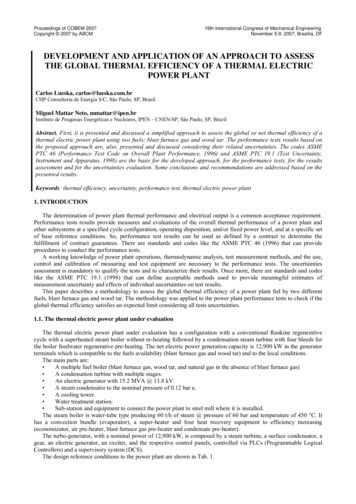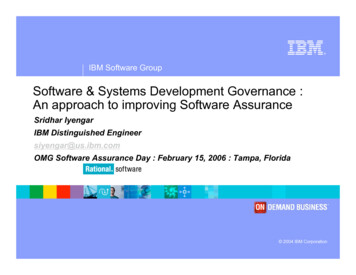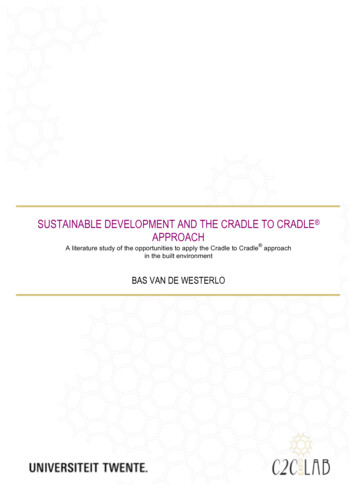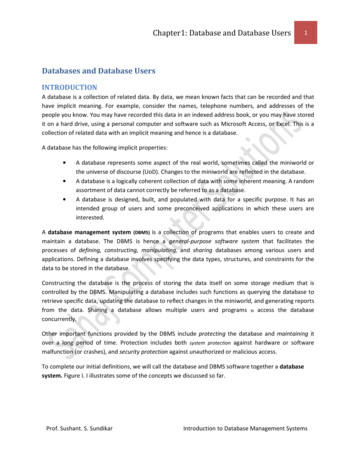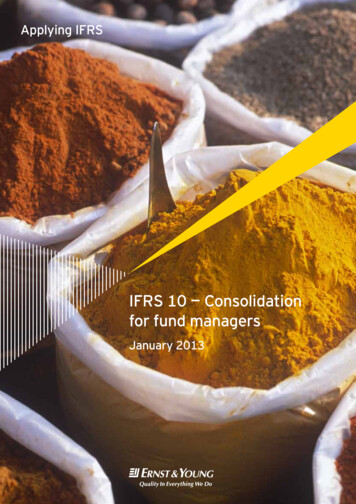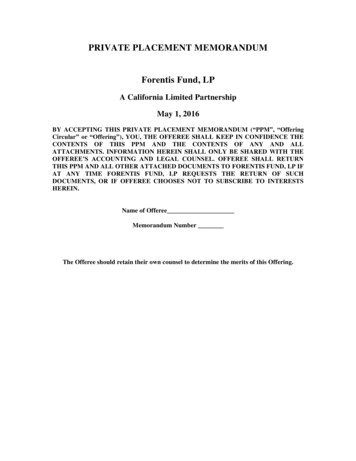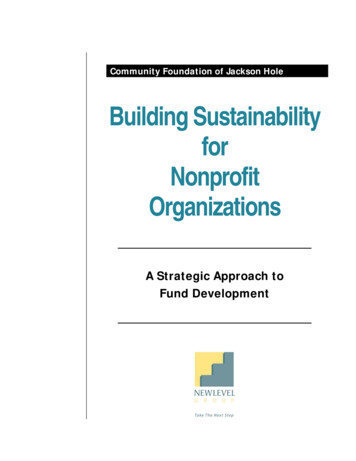
Transcription
Community Foundation of Jackson HoleBuilding SustainabilityforNonprofitOrganizationsA Strategic Approach toFund Development
Table of ContentsWelcome . 1Learning Objectives. 2Agenda. 3The Five Elements of Sustainability . 410 Important Things to Know about Fundraising. 6Tool: Six Fundamentals of Effective Fundraising Letters . 12Prospect Research. 14The Fine Art of Asking for the Gift. 18Asking for Money: The Close. 23Tool: Budget Gap Analysis . 28Tool: Strategic Fund Development. 29Next Steps . 30Recommended Reading List . 31About NewLevel Group35Building Sustainability for Nonprofit Organizations 2007-2012 NewLevel Group, LLCAll rights reserved. No part of this product may be reproduced, distributed,or transmitted in any form or by any means, including photocopying,recording, or other electronic or mechanical methods, without the priorwritten permission of the publisher.Building Sustainability for Nonprofit Organizations 2007-2012 NewLevel Group, LLC
WelcomeAre You Building An Organization That Will Last?Increasingly, funders and supporters are requiring nonprofits todemonstrate the sustainability of their efforts. But what does thatmean and how is it accomplished? Identifying the elements andprocesses that make an organization strong and charting a clearcourse for implementation are the first steps.A strategic approach to funding is critical to sustainability. With a wellthought out plan and focused execution, board development, staffdevelopment, recruiting, and program execution are all easier andmore effective. This workshop will allow Board members and staff ofnonprofit agencies to explore the basic principles and practices of astrategic approach to fundraising.This workshop is the third of a three-part series designed to exploreaspects of sustainability with emphasis on the elements of fundraising,marketing, and leadership development.A Strategic Approach to Fund DevelopmentCommunity Foundation of Jackson HoleMarch 14, 2012Building Sustainability for Nonprofit Organizations 2007-2012 NewLevel Group, LLCPage 1
Learning Objectives Acquire tools for building board support and participation infundraising Discover how to dispel common fears about fundraising Practice effective fundraising techniques Learn how to create the elements of a strategic fundraising plan Understand the importance of building relationships with donorsand supportersBuilding Sustainability for Nonprofit Organizations 2007-2012 NewLevel Group, LLCPage 2
Agenda Welcome, Introductions The Challenges of Fund Development Today A Strategic Approach to Fund Development 10 Important Things to Know about Fundraising Fundraising Theory: Fundamental Principles Putting Theory into Practice Developing Fundraising Strategies for your Organization Donor Relationship Management Wrap up and EvaluationBuilding Sustainability for Nonprofit Organizations 2007-2012 NewLevel Group, LLCPage 3
The Five Elements ofSustainability“To make the greatest impact on society requires first andforemost a great organization, not just a great program.”– Jim Collins, Good to Great and the Social SectorsWhile there is no one formula for building a high-performance socialsector organization, there are elements and processes that effectivenonprofit organizations have in common. The following is a checklist ofsome of those fundamental components.Clear and Compelling VisionBrief, well-defined vision and/or mission statementStatement of core valuesCommunity assessment and feedback processesFocused approach that is not redundant with other organizations’programsDefined measures of successPassionate and Engaged Board of DirectorsStrategic approach to board recruitment and successionBoard members are articulate advocates for the organizationClearly defined and consistently practiced roles and responsibilitiesClear expectations and accountability for board membersWritten policies and proceduresMotivated, Professional StaffClearly defined roles and expectationsSkills and experience commensurate with needsAppropriate compensationRespectful, supportive work environmentRegular, constructive feedbackAdequate resources availableBuilding Sustainability for Nonprofit Organizations 2007-2012 NewLevel Group, LLCPage 4
Effective Communications and MarketingStrategic marketing planClear, jargon-free messagingProactive communications to constituents and the communityNetwork of key influencersStrong, content-rich websiteGreat stories to demonstrate mission successStrategic Approach to Fund DevelopmentStrategic fundraising planDemonstrated support and participation by the boardBalanced portfolio of funding sourcesConstituent relationship management program in placeEndowments and reserve fundsBuilding Sustainability for Nonprofit Organizations 2007-2012 NewLevel Group, LLCPage 5
10 Important Things to Knowabout FundraisingBy Kim KleinMany times at the end of a training or a speech about fundraising techniquesand principles, I am asked, "What are the most important things toremember?" Usually the person asking is either a volunteer with little time tohelp with fundraising, a person new to fundraising and overwhelmed by thenumber of details she or he has to keep in mind, or a staff person who is notresponsible for fundraising but wants to help.Over the years, I have thought about what I consider the ten most important thingsto know about fundraising. The items are not presented in order of importance,although #1 is probably the most important; nor are they in order of difficulty.If there is any order, it is the order in which I understood these things andintegrated them into my own fundraising work. Undoubtedly, other skilledfundraisers would have slightly different lists, but this list has served me well formany years. I hope you find it useful.1. IF YOU WANT MONEY, YOU HAVE TO ASK FOR ITWhile there are some people (may their kind increase) who will simply send anorganization money or offer money without being asked, there are not enough ofthem to build a donor base around. Most people will not think to give you moneyunless you make your needs known. This is not because they are cheap or selfcentered; it is because most people have no idea how much it costs to run anonprofit, or how nonprofits get money. If you don't ask them, they will simplyassume you are getting the money somewhere. They have no reason to thinkyour group needs money unless you tell them, the same way they have no reasonto know if you are hungry, or unhappy, or needing advice.Millard Puller, founder of Habitat for Humanity, says, "I have tried raising moneyby asking for it, and by not asking for it. I always got more by asking for it."2. THANK BEFORE YOU BANKOnce you receive money, you must thank the person who gave it to you. I havefound that disciplining myself not to deposit checks until I have written the thankyou notes has forced me to make thank-you notes a priority. I am not rigid aboutthis rule because if I get behind in my thank-you notes, and then don't deposit thechecks for a while, the donors may wonder whether we really needed the money.Thank-you notes do not need to be fancy and should not be long. If at allpossible, they should include a personal note, even if it is from someone whodoesn't know the donor. You can add something as simple as, "Hope to meet yousometime," or "Check out our website," or "Happy holidays," or even, "Thanksagain — your gift really helps."Many organizations have created note cards for staff and volunteers to use whenwriting thank yous. The front of the card has the logo of the group, on the top halfBuilding Sustainability for Nonprofit Organizations 2007-2012 NewLevel Group, LLCPage 6
of the inside is a relevant meaningful quote from a famous person, and the bottomhalf of the inside is used for the thank-you message. It is a small space, so youreally can't say much.Many databases will print out a thank-you note after you enter the informationabout the donor — saving valuable time. These are best if accompanied by apersonal note at the bottom.Late thank yous are better than no thank you at all, but photocopied formthank yous are almost the same as no thank you.The long and the short of thank yous is: if you don't have time to thankdonors, you don't have time to have donors.3. DONORS ARE NOT ATMSA survey of donors who gave away more than 5,000 a year asked, "What is yourrelationship with your favorite group?" Several gave similar answers, even thoughthey did not know each other and did not give to the same group. All the answerswere on this theme: "I would love to be considered a friend, but I am more of anATM. They come to me when they need money, they tell me how much, Igive it to them, and the next time I hear from them is when they need more."This is a terrible indictment of much of what passes as fundraising. When I havedescribed this common situation in trainings, people have often asked, "How canwe make sure our donors don't feel this way?" The answer is very simple,"Make sure you don't feel that way about your donors."All groups have a few "high maintenance" donors, and may be forgiven for wishingthem to go on a long trip to a place without phones or e-mail. But the majorityof donors require practically no attention. They have the resilience of cacti —the slightest care makes them bloom. Thank-you notes, easy-to-understandnewsletters, and occasional respectful requests for extra gifts will keep peoplegiving year in and year out.Think of your donors as ambassadors for your group. Design your materials sothat donors will be proud to give your newsletter to a friend or recommend yourgroup when their service club or professional association is looking for aninteresting speaker, or forward your e-mails to several of their colleagues.By treating your donors as whole people who have a number of gifts to offer yourgroup, including their financial support, you will have more financial supportfrom existing donors, more fun fundraising, more donors, and the peace ofmind of knowing that you are not treating anyone as an object.Building Sustainability for Nonprofit Organizations 2007-2012 NewLevel Group, LLCPage 7
4. MOST MONEY COMES FROM PEOPLE, AND MOST OF THOSE PEOPLE ARENOT RICHThere are three sources of funding for all the nonprofits in the United States: earnedincome (such as products and fees for service), government (public sector), andthe private sector, which includes foundations, corporations and individuals. Forthe nearly 60 years that records about who gives money away have been kept, atleast 80% of this money has been shown to be given by individuals.In 2002, total giving by the private sector was almost 241 billion, and 84.2 percentof that ( 202 billion) was given away by individuals! These people are all people –there is no significant difference in giving patterns by age, race, or gender. Incomeis not nearly the variable that one would think: middle-class, working-class, andpoor people are generous givers and account for a high percentage of the moneygiven away. In fact, a study by Arthur Blocks of the Maxwell School of Citizenship andPublic Affairs at Syracuse University showed that 19% of families living on welfaregive away an average of 72 a year!Too often, people think they can't raise money because they don't know anywealthy philanthropists. It is a great comfort to find that the people we know,whomever they are, are adequate to the task. Seven out of ten adults give awaymoney; focus your work on these givers, and help teach young people to becomegivers.5. PEOPLE HAVE THE RIGHT TO SAY NOOne of the biggest mistakes I made early on as a fundraising trainer was notbalancing my emphasis on the need to ask for money with the reality thatpeople are going to say no. No one is obligated to support your group — nomatter what you have done for them, no matter how wealthy they are, nomatter how much they give to other groups, how close a friend they are of thedirector, or any other circumstance that makes it seem they would be a likelygiver.While it is possible to guilt-trip, trick, or manipulate someone into giving once,that will not work as a repeat strategy. People avoid people who make themfeel bad, and they are attracted to people who make them feel good. Whenyou can make someone feel all right about saying no, you keep the door opento a future yes, or to that person referring someone else to your group.People say no for all kinds of reasons: they don't have extra money right now;they just gave to another group; they don't give at the door, over the phone, bymail; a serious crisis in their family is consuming all their emotional energy; theyare in a bad mood. Rarely does their refusal have anything to do with you oryour group. Sometimes people say no because they have other priorities, orthey don't understand what your group does. Sometimes we hear no when theperson is just saying, "I need more time to decide," or "I need moreinformation," or "I have misunderstood something you said."Building Sustainability for Nonprofit Organizations 2007-2012 NewLevel Group, LLCPage 8
So, first be clear that the person is saying no, and not something else like, "Notnow," or "I don't like special events." Once you are certain that the person hassaid no, accept it. Go on to your next prospect. If appropriate, write the persona letter and thank them for the attention they gave to your request. Then let itgo. If you don't hear ‘no’ several times a week, you are not asking enough people.6. TO BE GOOD AT FUNDRAISING, CULTIVATE THREE TRAITSA good fundraiser requires three character traits as much as any set of skills. Thesetraits are: first, a belief in the cause for which you are raising money and the abilityto maintain that belief during defeats, tedious tasks, and financial insecurity; second,the ability to have high hopes and low expectations, allowing you to be often pleasedbut rarely disappointed; and third, faith in the basic goodness of people.While fundraising is certainly a profession, people who will raise money for any kindof group are rarely effective. Fundraising is a means to an end, a way to promote acause, a very necessary skill in achieving goals and fulfilling missions.7. FUNDRAISING SHOULD NOT BE CONFUSED WITH FUND CHASING, FUNDSQUEEZING, OR FUND HOARDINGToo often, organizations get confused about what fundraising is and is not.If you hear that a foundation is now funding XYZ idea, and your organizationhas never done work in that area nor have you ever wished to do work in thatarea, the fact that you are well-qualified to do such work is immaterial. To apply fora grant just because the money is available and not because the work willpromote your mission is called fund chasing. Many groups chase money all overand, in doing so, move very far away from their mission.Similarly, if your organization seems to be running into a deficit situation, cuttingitems out of the budget may be necessary but should not be confused withfundraising. When deficits loom, the fund-squeezing question is, "How can wecut back on spending?"; the fundraising question is "Where can we get evenmore money?"Finally, putting money aside for a rainy day, or taking money people have givenyou for annual operating and program work and being able to put some of itinto a savings account is a good idea. Where savings becomes hoarding,however, is when no occasion seems important enough to warrant using thesavings.I know a number of groups that have cut whole staff positions and programareas rather than let money sitting in their savings be used to keep them goinguntil more money could be raised. I know groups that overstate what they paypeople, what price they pay for equipment, what they spend on rent, all to getbigger grants from foundations or larger gifts from individuals, and then putthat extra into savings — savings that they have no plan for.A group that saves money needs to have a rationale: Why are you saving thismoney? Under what circumstances would you spend it? Without some plan inmind, the group simply hoards money.Building Sustainability for Nonprofit Organizations 2007-2012 NewLevel Group, LLCPage 9
Fund-chasing, fund-squeezing, and fund-hoarding need to be replaced with anethic that directs the group to seek the money it needs, spend it wisely, and setsome aside for cash-flow emergencies or future work.8. FUNDRAISING IS AN EXCHANGE — PEOPLE PAY YOU TO DO WORK THEYCANNOT DO ALONEHank Rosso, founder of the Fund Raising School and my mentor for many years,spoke often about the need to eliminate the idea that fundraising was likebegging.Begging is when you ask for something you do not deserve. If you are doinggood work, then you deserve to raise the money to do it. What you must do isfigure out how to articulate what you are doing so that the person hearing it, ifthey share your values, will want to exchange their money for your work. They willpay you to do work they cannot do alone.9. PEOPLE'S ANXIETIES ABOUT FUNDRAISING STEM FROM THEIRANXIETIES ABOUT MONEYAnxiety about money is learned, and it can be unlearned. If you are ever aroundchildren, you know that they have no trouble asking for anything, especially money.In fact, if you say no to a child's request for money, they will simply ask again, orrephrase their request ("I'll only spend it on books"), or offer an alternative ("Howabout if I do the dishes, then will you give me the money?")Everything we think and feel about money we have been taught. None of it isnatural; none of it is genetic. In fact, in many countries around the world,people talk easily about money. They discuss what they earn, how much theypaid for things, and it is not considered rude to ask others about salaries and costs.We have been taught not to talk about money or to ask for it, except undervery limited circumstances. Many of us are taught that money is a private affair.Having too little or too much can be a source of shame and embarrassment, yetmoney is also a source of status and power. Most people would like to have moremoney, yet most will also admit that money doesn't buy happiness.As adults, we have the right — in fact, the obligation — to examine the ideas wewere taught as children to ensure that they are accurate and that they promotevalues we want to live by as adults. Most of us have changed our thinking aboutsex and sexuality, about race, about age, illness and disability, about religion,about marriage, about how children should be raised, what foods are healthy,and much more. We have done this as we have learned more, as we haveexperienced more, or, as we have thought about what we value and what wedo not. We need to take the time to do the same work with our attitudestoward money. We can choose attitudes that make sense and that promote ourhealth and well-being.Our attitudes toward fundraising are a subset of our larger attitudes towardmoney. The most important change we can make in our attitudes towardfundraising is to remember that success in fundraising is defined by how manypeople you ask rather than how much money you raise. This is because somepeople are going to say no, which has got to be all right with you. The morepeople you ask, the more yes answers you will eventually get.Building Sustainability for Nonprofit Organizations 2007-2012 NewLevel Group, LLCPage 10
Finally, if you are anxious about asking for money or would rather not ask, this isnormal. But ask yourself if what you believe in is bigger than what you are anxiousabout. Keep focused on your commitment to the cause and that will propel youpast your doubts, fears, and anxieties.10. THERE ARE FOUR STEPS TO FUNDRAISING — PLAN, PLAN, PLAN, AND WORKYOUR PLANThough humorous, this formula thatunderscores the fact that fundraising islearned this later in my career, afterfundraising campaigns and programs. Ijust never got around to planning.I learned from a community organizerthree parts planning for one part doing. Ihaving gone off half-cocked into manymeant to plan, I planned to make a plan, II have learned (usually the hard way) that an hour of planning can save five hoursof work, leaving much more time both to plan and to work. Planning also avoidsthat awful feeling of "How can I ever get everything done," and that sense ofimpending doom. It moves us out of crisis mentality and means that we aregoing to be a lot easier for our co-workers to get along with.There are a lot of articles and books on planning — I recommend reading someof them. However, the easiest way I have found to plan something is to start bydefining the end result you want and when you want it to happen, then workbackwards from that point to the present. For example, if you want yourorganization to have 100 new members by the end of next year and you are goingto use house parties as your primary acquisition strategy, you will need toschedule five to seven house parties that will recruit 10 to 15 members per party.To set up one house party will require asking three people to host it (only one willaccept), which will require identifying 15 or 20 possible hosts to carry out thenumber of house parties you want to have. The hosts will want to see materialsand know what help they will have from you.The materials will have to be ready before the first phone call is made to the firstpotential host, and the first phone call needs to occur at least two months beforethe first party. So, the materials need to be produced in the next two weeks,hosts identified in a similar timeframe, calls made over a period of two or threemonths, and so on.When you are tempted to skip planning, or to postpone planning until you "havesome time," or to fly by the seat of your pants, just remember the Buddhistsaying, "We have so little time, we must proceed very slowly."Building Sustainability for Nonprofit Organizations 2007-2012 NewLevel Group, LLCPage 11
Tool: Six Fundamentals ofEffective Fundraising LettersThe reason many donors cite for giving money? They wereasked!One of the most common methods that nonprofits use to raise funds is the appealletter. Not only can an appeal letter bring in much needed funds, it can strengthenthe connection with current supporters, reactivate lapsed donors, encourage moredonors to become major donors, and increase the size of major donor gifts.How effective was your last appeal letter to existing donors? If you didn’t receive atleast a 6% response from your mailing list, try using these six fundamentals for yournext campaign.1.Develop a unifying concept or themeYour theme could be centered on a recent event (for example, last year we tiedone client’s fundraising letter to the national hurricane disasters); a majorsuccess; a compelling beneficiary story; or, a new program or populationserved.2.Acknowledge your donorWe all want to be appreciated and feel that we are making an impact. Be sureto thank your donor within the first paragraph of your letter and let them knowhow their donations have made a difference to the clients your organizationserves.3.Make it easy to readStudies have shown that the typical appeal letter has about 20 seconds to grabthe reader before it ends up in the trash. Furthermore, 90% of donors start byreading your P.S. The key is to write a strong P.S. and compose the letter withsubheads and brief paragraphs.4.Tell an emotional storyPut a face on your organization with an upbeat story about how yourorganization helped a client. If confidentiality isn’t an issue, use photographsand names of clients.Building Sustainability for Nonprofit Organizations 2007-2012 NewLevel Group, LLCPage 12
5.Personalize itIf at all possible, your envelope should be hand-addressed and hand-stamped,and the letter should be addressed to each donor by name. Personalizing yourappeal has been shown to increase your response rate by almost 30%!6.Create a stand-out reply cardLet’s say your mailing has managed to stay out of the trash, piqued yourdonor’s interest, but has been relegated to the dreaded bill pile where it may sitfor weeks. Make it stand-out with a larger format, interesting graphics, and asummary of your appeal.Point to Remember:Communicate with your donors at least four times a year, including twoappeal letters. The other two pieces can include a simple newsletter, or anupdate about your organization’s successes. By reaching out to your donorson a regular basis, you will be building relationships that will help sustainyour organization in the future.Building Sustainability for Nonprofit Organizations 2007-2012 NewLevel Group, LLCPage 13
Prospect Researchby James ToscanoAs part of a group organizing a development office for The Saint Paul ChamberOrchestra years ago, I ran a number of mailing lists by the committee. Certainly allagreed that season ticket holders were clearly a prime constituency. When we got tothe single ticket buyer list, derisive comments emanated from staff about a “dog list.”“If they can’t even afford season tickets, they’re nowhere near giving us money”went up the dismissive cry.“Wait a minute.” chimed in the volunteer fundraising consultant, “Who’s to say thatnot buying a season ticket disqualifies them? Maybe they’re very busy people, orhighly sophisticated about the music they want to hear, or just don’t like most ofyour subscription concerts!”After the artistic temperaments settled down, I offered to do a pilot campaignthrough direct mail and telefunding. The results were so spectacular that weexpanded the effort to the entire list, netting a 25 percent return and about eightythousand “dog” dollars, as I called them. These donors were sitting right in front ofthem all the time!The LessonThe lesson is obvious. Don’t let your perceptions and stereotypes get in the way ofdeveloping your organization’s constituency. Get to know your constituency and do itstrategically and systematically.Donation dollars follow values; donors share explicit and implicit values with thenonprofit organizations they support. Donor values, interests, relationships andinvolvement are paramount. Now, how do we find these donors?The lesson learned in the anecdote above is that many are already in our “seats.”Institutional memory being what it is, we often forget founders, former boardmembers, former foundation, government and organization funders, formerindividual donors, former participants or clients, and former volunteers. That’s oneplace to start.Dumping Former DonorsFor example, I’m constantly amazed at how rapidly we dump names of donors whodon’t give for a few years without even asking them why they’re not giving.When you think that the average person initially makes a donation after about sevento eight requests, it seems plainly inefficient to let them slide away after two or threeconsecutive years of non-giving. Perhaps they’ve been away, or have kids in college,or have been ill, or moved, or a thousand other things that led to a non-response.Building Sustainability for Nonprofit Organizations 2007-2012 NewLevel Group, LLCPage 14
Or, and this is the case with many, we are just not familiar enough with them tohave our request at the top of their consciousness. With institutional donors, it maybe an implicit rotation, or change in guidelines or interests, which do sometimesbounce back.While we would like to think that we are the most important thing in people’s lives,for example, we are not, and sometimes we are marginal to the point that theyforget to send money, not because they don’t want to but because other events inbusy lives have precluded us.Volunteers as DonorsAnother example is that we often separate out volunteers, citing the cliché abouttheir giving “time not money.” However, study after study, census after censusdemonstrate that households in which there is not significant volunteering contributealmost half as much as those with volunteers. Our volunteers are our prospects anddonors!Clearly volunteering is a function of education and/or income; in this instance,however, the volunteer is on our scene and he or she knows us, shares our values,and is a wonderful prospect for a donation or an increase in an existing donation.The Importance of ResearchOne of the most useful exercises with boards, development committees, volunteersolicitors and staff is to do as detailed a constituency circle (or pyramid) as possible,not just once, but continuously, posting the chart in a prominent place at alldevelopment committee and rating committee meetings.Asking the committed to identify a development prospect is a double win: a newname and a potential peer solicitor of the prospect.Hank Rosso separated the major headings in this exercise into “ Suspect, Prospect,and Donor.” However it is done, either in concentric circles or ascending levels in apyramid denoting involvement and commitment, the task is the same: to fill inspecific names and/or characteristics of persons, foundations, corporations,organizations and government agencies.Research is the centerpiece of this work to identify constituency, and it comes in allshapes and sizes. All of those names elicited in the exercise above then become thesubjects of further research.The Best Source of Information on a ProspectObviou
Public Affairs at Syracuse University showed that 19% of families living on welfare give away an average of 72 a year! Too often, people think they can't raise money because they don't know any wealthy philanthropists. It is a great comfort to find that the peo




